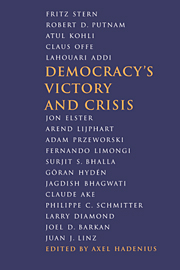Book contents
- Frontmatter
- Contents
- List of contributors
- Acknowledgments
- 1 Victory and crisis: introduction
- Part 1 Historical perspectives
- Part 2 Social and cultural aspects
- Part 3 Constitutional questions
- 7 Ways of constitution-making
- 8 Back to democratic basics: who really practices majority rule?
- Part 4 Democracy and development
- Part 5 Democracy and globalization
- Part 6 Promoting democracy
- Index
8 - Back to democratic basics: who really practices majority rule?
Published online by Cambridge University Press: 13 October 2009
- Frontmatter
- Contents
- List of contributors
- Acknowledgments
- 1 Victory and crisis: introduction
- Part 1 Historical perspectives
- Part 2 Social and cultural aspects
- Part 3 Constitutional questions
- 7 Ways of constitution-making
- 8 Back to democratic basics: who really practices majority rule?
- Part 4 Democracy and development
- Part 5 Democracy and globalization
- Part 6 Promoting democracy
- Index
Summary
Democracy's victory in the 1990s, while a major development in world history, is only a partial victory. It represents the defeat of Communism, Fascism, and other ideological anti-democratic forces, but democracy continues to face enemies of a different nature: in particular, the deep ethnic-communal divisions within countries, often aggravated by great socioeconomic inequalities, which pose a grave threat to the viability and consolidation of democracy in the many newly democratic countries.
The leitmotiv of much of my previous work has been that the challenge of deep cleavages does not represent an insuperable problem. Democracy of the “consociational” or “consensus” type – similar concepts, although I have denned them in slightly different terms (Lijphart 1977, 1984) – provides formal and informal constitutional rules that can facilitate interethnic and intercommunal accommodation. The two most important elements are broad participation in decision making by the representatives of the different ethnic-communal groups and cultural autonomy for those groups that wish to have it. The empirical evidence for this proposition is very strong. For instance, Ted Robert Gurr's recent Minorities at Risk (1993: esp. 290–313), a massive study of all of the world's minorities in the post-World War II era, concludes that, first of all, intercommunal conflict is by no means intractable; that, second, partition and secession do not work well, mainly because it is in practice very difficult to draw boundaries in such a clean and neat way that homogeneous countries are created; but that, thirdly, there are methods that do work, namely broad power-sharing and group autonomy.
- Type
- Chapter
- Information
- Democracy's Victory and Crisis , pp. 143 - 160Publisher: Cambridge University PressPrint publication year: 1997
- 5
- Cited by



